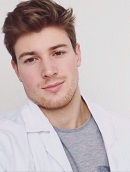
Christoph Wippel, Medical University of Vienna, Austria
by Christoph Wippel
Travelling has always been one of the greatest joys for me. Broadening my horizon by exploring other countries, getting acquainted with new cultures, discovering unfamiliar foods and creating unique memories is a big part of what life is about for me.
For this reason, it should not be difficult to believe that I couldn’t wait to reach my fifth year of studies at the Medical University of Vienna. The fifth year is when we are eligible to go abroad for three out of the final four semesters of studies. For me it has always been clear that I would seize this opportunity fully and spend the maximum amount of time in foreign countries and hospitals around the world to get an international experience as much as possible. I started my almost two-year-long journey with an ERASMUS semester at the Descartes University in Paris, France, which is what I would like to focus on in this report.
“Why Paris?”, you might ask. Why did I choose this dirty, overcrowded, overpriced and tourist-overrun city with its stereotypically arrogant and querulous citizens as a place to live for six months?
In retrospective, the list of reasons “why” would by far exceed the limit of this report, which might slightly be biased by the fact that I have unequivocally fallen in love with this city.
For the sake of not letting this report extravagate into a love letter of the city, let me just tell you this: Everything you have ever heard about Paris is true, the good and the bad.

(c) Christoph Wippel: City of Lights – Place de la Concorde
Paris is the city of love. It is a proven fact that a couple falls in love every three seconds in Paris (according to very reliable studies).
Paris is the city of light. Interesting fact: Did you know it is referred to as “The City of Light”, both because of its leading role during the Age of Enlightenment, and more literally because Paris was one of the first European cities to adopt gas street lighting?
Last but not least, Paris is the city of culture and sophistication par excellence. Not for nothing has the city inspired poets and artists for centuries, with its iconic art and architecture, coffee culture and air of romance. On top of that, or maybe because of that, it might as well be one of the most beautiful places I have ever lived in. And after all, according to Audrey Hepburn “Paris is always a good idea”.
My initial motivation for going to Paris was simply to learn and develop an understanding of the language with the long-term goal in mind of working with Médecins Sans Frontières (Doctors without Borders) at some point in my medical career, which just happens to be an originally French organization that operates in many francophone countries. For this reason, obtaining some of my medical training in France seemed like a very logical step.
Application process
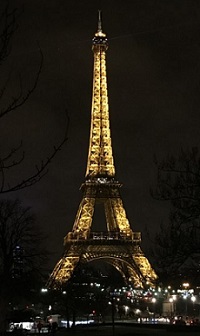
(c) Christoph Wippel: Eiffel Tower by night
The application process was very straight-forward and depends on the university’s ERASMUS regulations. Since the Descartes University is a partner school of the Medical University of Vienna, I simply had to register in the International Relations section of my medical school’s online student access homepage before the given deadline. I had to rank three choices of partner universities in order of preference. Students are then placed according to their “academic merit”, which is just a fancy wording for the scores of my three big annual exams I had passed so far. I was notified about my successful match with my first preference in December, one year prior to the start of the Erasmus semester. I could choose the length of my stay, anywhere between three and twelve months. I chose the golden middle of 6 months and decided to complete four out of seven clinical rotations of the fifth year at the Descartes University. I had to prove a B2-language proficiency in French for a successful placement. Since my school-French had been dormant for quite some years, you can imagine that this did pose a little bit of a problem for me. For this reason, I decided to take two French courses at the Language Center of the University of Vienna. The classes were a lot of fun and proved at least on paper my ability to communicate in French on a B2 level, which would later turn out to not even remotely be the case in reality.
Finding my accommodation – a challenge!
As the time of departure came closer I started to become a little bit concerned with the question of where I would find an accommodation? Neither ERASMUS, nor my university were a very big help in this regard, at least not for a placement in Paris. I tried my luck on several flat share websites and Facebook, but not being locally present and with my then still very limited French skills, it turned out to be very tricky to find a room, especially for only a limited amount of time.
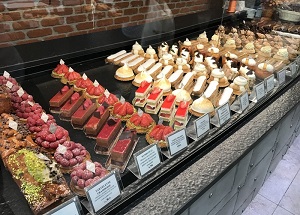
(c) Christoph Wippel: Pastry is an artform in Paris
I was getting very frustrated in my search for an urban habitat when I found out about the so-called “Cité Universitaire”, an enormous student residence that was established after “World War I” in order to create a meeting place for students from around the world in a spirit of peace and unity. It includes 40 houses, most of them designated to a specific country and some with a quite impressive architecture. The application for a room was very simple through the website. It was a big relief after my burdensome and unsuccessful search for an accommodation in the French capital. I was assigned to a small studio apartment including a bathroom and a small kitchen in the Maison de Provinces de France for the entire length of my semester. Looking back, I couldn’t have been happier with this choice of accommodation. Located in the 14th arrondissement in the south of Paris right at the convenient RER metro line, the Cité provided an excellent hub to go out and explore the city and especially the wide green areas and the adjacent park Montsouris proved to be an excellent place to relax and study during the warmer spring and summer months.
The clinical rotation à la française
In France one clinical rotation is always 3 months. Starting in their second year of studies, French medical students spend every morning in the hospital and leave between 12 pm and 1 pm to attend school classes, lectures or various seminars in the afternoon. Rotations at my University (Medical University of Vienna) during my fifth year were only intended to last 4 weeks and I had to complete 7 in total. Since the French University was not very flexible with the length of rotations, it was a bit difficult to accommodate 4 rotations in six months. The agreement was that I would complete two rotations of 3 months respectively in the mornings and during two out of the six months I would do another 2 rotations in the afternoons but only for four weeks each.
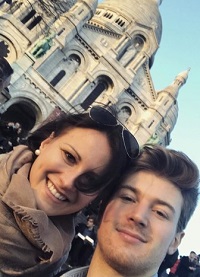
(c) Christoph Wippel: Being tourists at Sacre Coeur
I started my first rotation in Neurology at the Hôpital Sainte Anne. The hospital, established in 1651, is one of Paris’ oldest medical institutions and specialized in Psychiatry and Neurology. On my way to the hospital on the first day, I felt very nervous, mainly because I was not confident with my level of French at all. Getting there I had to master my first conversations by asking around where to find the way to the Neurology conference room. Everything went fine so far. I found the right room or at least I thought so, because I was one hour early, and nobody was there yet. I didn’t mind though, since this gave me more time to settle in and go over some of the basic phrases in my head “Salut, je m’appelle Christoph.”, “Je suis étudiant Eramsus d’Autriche.” etc. I was very anxious for the first co-students to come in and talk to me. We were about 15 students, spread across three wards and I turned out to be the only foreign student among them. The first day was only an introductory day. We were told our responsibilities, our working hours, the usual procedures and rules of the service. We were assigned night shifts, our week of vacation and we registered at the administration office. This was a lot of information to take in for me and since I didn’t understand most of it, I only learned about it afterwards when two very friendly and supportive co-students went over everything again with me in a veeery slow French.
All the students were assigned to one of the “Internes”, the junior doctors, who were responsible for us and gave us various tasks and little teaching sessions throughout the day. Every three weeks we rotated to a different section of the ward, each with a slightly different specialization, e.g. strokes, parkinsons, multiple sclerosis etc. Each student was responsible for three patients and took care of these patients from admission to discharge. Furthermore, we had to examine them every day before rounds, present them during rounds, write notes, order labs or refer them for imaging.
Even though everybody was really nice and understanding, the first few weeks were a nightmare for me. It turns out that using a foreign language in a professional setting is a very different thing than speaking it in the sheltered environment of a language course. Even understanding basic things and what was going on around posed me a lot of difficulties.
For the first three to four weeks I was essentially just passively tagging along with my co-students, observing and here and there asking questions. There were innumerable occasions where I felt just plain dumb. But to my own astonishment, all the doctors were incredibly sympathetic with me and slowly I started to notice improvements. During the second month my French got a lot better, and I felt confident enough to take on one patient by myself. Everything still took me a lot longer than my fellow students. But to have responsibility for one patient seemed like a decent work load and I didn’t feel as useless anymore as I did at the beginning. By the end of my first 3-month rotation I felt like I was a fully functioning member of the team with the same responsibilities as my co-students. I was able to understand pretty much everything, and I could communicate proficiently with my patients.
In the course of every rotation each student has to give a 30-minute presentation about a related topic in the respective field of the rotation. Luckily mine was at the very end of the rotation when I felt a little bit more at ease with the language. Nonetheless, presenting a medical topic in front of all my colleagues in French was still a very big deal for me. Mastering it was the final hurdle before going into my next rotation, but now with full confidence.
Gynecology and Obstetrics
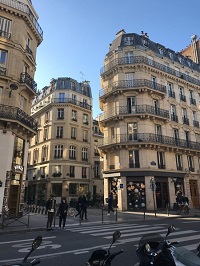
(c) Christoph Wippel: Étienne Marcel
My second rotation was in Obstetrics at Port Royal Maternité, one of Paris’ biggest maternity centers. Again, we were about 15 students at the service and we rotated every two weeks between the wards, the day-clinic and the operating and delivery rooms. Our responsibilities were taking care of patients, presenting them at the morning rounds, assisting in the OR during Caesarean-sections and of course “normal” deliveries or simply observing in the clinic.
For my afternoon rotations, I did one month in Pediatric Cardiac Surgery at Hôpital Necker, Paris’ biggest and a world-renowned children’s hospital, and one month in Intensive Care at the Institut Mutualiste Montsouris. Since French medical students only work in the mornings, I was the only student there, which gave me even more chance to work closely together with the doctors.
Overall the rotations are very well organized and structured, every student has his/her responsibilities and duties, there are plenty of teaching opportunities and doctors are generally very friendly and delighted if you show interest. You can feel that this system of students working in the hospital has been well established in French medical schools. Everybody is very used to having students around and the team really relies on the work of their students. The students, for their part, having been involved in hospital work from their second year of medical school on, are very well versed and confident in clinical and patient related work – one of the biggest differences compared to the medical education system in Austria or Germany.
Administrative challenges
To conclude this report, I will go over some administrative topics that are probably good to know. France is known for its overly complicated bureaucracy and not surprisingly I spent a good amount of the first two weeks running around the city trying to get all my paper work done.
During the first days upon arrival, students are asked to go to the International Office of the University to hand in all ERASMUS papers, the passport, bank information etc. in order to get an inscription confirmation and a student ID card. Hospitals in France pay their students a small amount as compensation for their work. Prerequisite for a payment, however, is a French bank account. Finding a bank that would accept students who are in the country only for six months was not a very easy task. I got lucky with the Societé Général, which also offered a 100-euro bonus for students of the Descartes University.

Eiffel Tower
The city of Paris offers financial housing aid to all European citizens. It is a very complicated and lengthy process to apply for this aid, but you are pretty much guaranteed to receive between 100 and 200 euros a month, so it is definitely worth it! They ask for an international birth certificate, which you can easily get from your local authority at home. You then have to sign up on the website. With the printed confirmation and all your other documents (university inscription confirmation, copy of your passport, confirmation of your Paris residence, tenancy agreement, birth certificate etc.) you go to one of the CAF centers and register. It can take up to 3 months until you get your compensation.
Transportation can be quite expensive in Paris, but the metro system is one of the best in the world. Also, there is a law which requires employers to pay half of their employees’ transportation costs. This includes the hospital where students complete their rotations. For this reason, it is worth getting a “PassNaviGO” for about 70 euros a month because you get reimbursed about 35 euros from the hospital.
Paris is a very expensive city, there is no doubt about it. However, with the ERASMUS scholarship, the small salary from the hospital, the CAF housing financial aid and the transportation reimbursement, it is affordable to anyone, so this should definitely not be a reason that keeps you from going to Paris. And on top of all that, if you’re a European Citizen under the age of 26, all the big and famous museums and sights (Louvre, Musée d’Orsay, Centre Pompidou, Arc de Triomphe etc.) are completely and entirely free!!!
Interesting websites:
- All the information you need about the ERASMUS+
- Official website of the Université Paris Descartes.
- Official website of the housing financial aid.
- Official website of the Cité Universitaire, student residence Paris.
- Online market website, like willhaben.at in case you want to buy a second hand bike or anything you might need.
- Official website of the Paris public transport, including information about the passNAVIGO.
- Necker Children’s Hospital – official website.
- Saint Anne Hospital for Neurology and Psychiatry – official website.
- Official website of the Société Générale, one of the few banks that accept students on a short-term basis.
Here you can download the experience report as PDF file.
If you are interested in working abroad as a medical student or doctor, click here for more information.
Published in GI-Mail 04/2018 (English edition) and GI-Mail 05/2018 (German edition). Sign up for GI-Mail here. 
Tip: More up to date educational events can be found online in the Education Database »medicine & health«.
